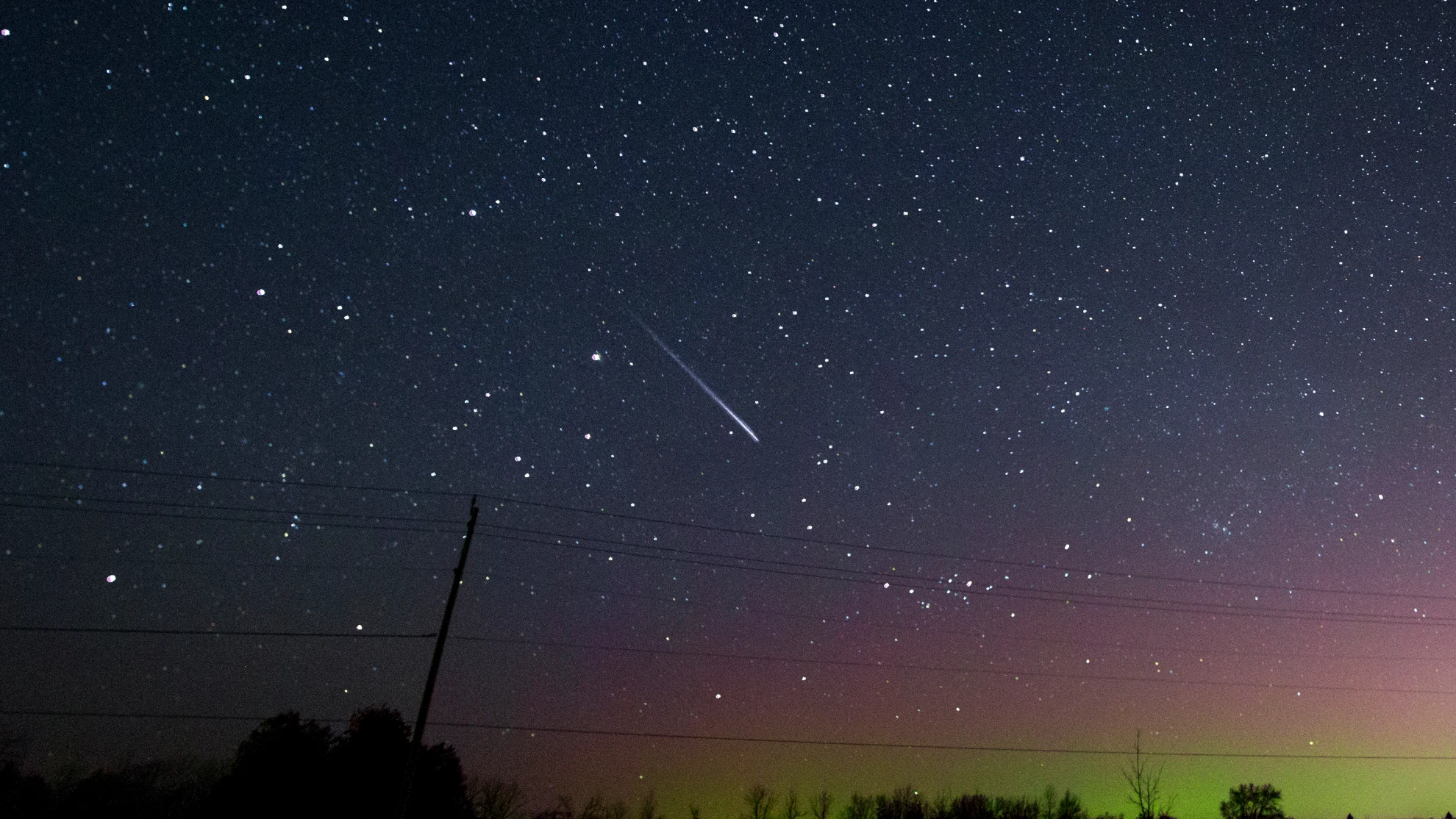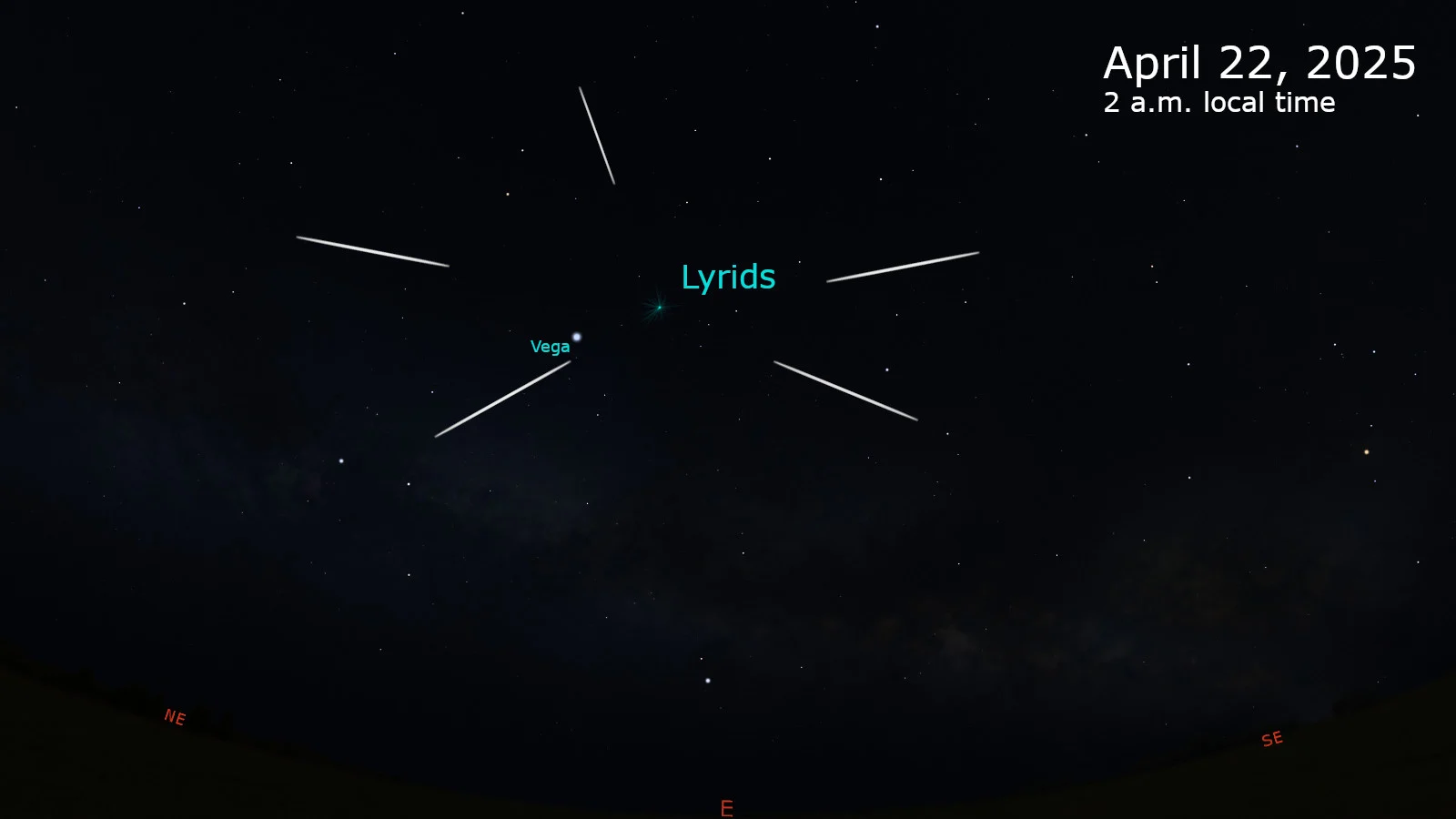
Look up! Lyrid fireballs will streak through the sky tonight
The oldest meteor shower on record peaks Monday night
After over three months of meteor shower drought, the Lyrids reach their annual peak tonight.
One week ago, on April 14, Earth slipped into a fast-moving stream of ice and dust in space. This trail of debris is left behind by an ancient comet known as C/1861 G1 (Thatcher).
As our planet's atmosphere sweeps up these bits of comet debris, they produced bright streaks of light called meteors. With these meteors all appearing to originate from within the constellation Lyrid, this has come to be known as the annual Lyrid meteor shower.

This simulation shows the orbit and debris stream from Comet Thatcher, as viewed from far 'above' the solar system's orbital plane. The locations of the inner planets are indicated as of April 22, 2025, with Earth very close to the orbital path of the comet. Credit: Meteorshowers.org/Scott Sutherland
DON'T MISS: Get to know the hidden gems across Canada
Each year, the Lyrids start off fairly quiet for the first week. We might see just a few meteors each night for the first couple of days. Then, on each following night, their numbers ramp up, to one or two per hour, then 5 per hour, then 10, and so on, until the night of April 21-22. That is when Earth reaches the densest part of Comet Thatcher’s debris stream and the Lyrid meteor shower reaches its peak.

The radiant of the Lyrid meteor shower is shown in the northeast sky in this simulation of the night for April 21-22, 2025. Credit: Stellarium/Scott Sutherland
The number of Lyrids is fairly consistent year to year, reaching up to 20 meteors per hour during the shower's peak.
However, sky conditions have an impact on exactly how many meteors an observer may see during the shower's peak.
To maximize your potential for spotting these brief flashes of light, check your weather forecast and look for 'partly cloudy' or 'clear' skies. Also, the event is best viewed from somewhere with a dark sky, far from city lights.
Just as with urban light pollution, moonlight can take its toll on how many meteors we see. With the Lyrids peak timed to occur during the Last Quarter Moon, a few of the dimmer meteors could be washed out by moonlight in the hours after midnight, after the Moon rises.
Fireballs and outbursts
Athough the Lyrids only rank as a 'moderate' meteor shower (compared to the stronger Quadrantids, Perseids, and Geminids), they do include an extra special treat — exceptionally bright meteors known as fireballs.
A fireball is any meteor that shines at least as bright as the planet Venus in our sky. Some are bright enough to be spotted from hundreds of kilometres in all directions.

This image of a Lyrid meteor fireball was captured from Port Elmsley, Ontario, along with the Aurora Borealis, in April of 2017. (Fiona Donnelly/UGC)
READ MORE: Look up! What's going on in the April night sky?
Fireballs are common during the Lyrids due to the exceptional speed that comet Thatcher debris travels at in the stream. Hitting the top of Earth's atmosphere at around 100,000 km/hr, anything bigger than a grain of dust causes a spectacular streak of light as it burns through the sky.
Lyrid fireballs are even bright enough to be seen with a Full Moon in the sky. So, keep an eye out for them throughout the night.
Also, if you are out observing the Lyrids, consider that you're viewing the oldest of all the meteor showers we see each year. According to records, it has been observed for over 2,700 years!
Plus, while we only see around 20 meteors per hour from the Lyrids, every 60 years, there's an 'outburst' of activity.

This composite all-sky camera image shows a mix of Lyrid and non-Lyrid meteors over New Mexico from April 2012, including a few Lyrid fireballs. NASA/MSFC/Danielle Moser.
According to Sky and Telescope magazine, "Chinese court astronomers reported a Lyrid outburst on March 16, 687 BC when 'in the middle of the night, stars fell like rain.'"
During the last outburst, in April 1982, the Lyrids rivalled the August Perseids or the December Geminids, producing over 100 meteors per hour during their peak. The next such outburst isn't expected until 2042.
With files from The Weather Network
